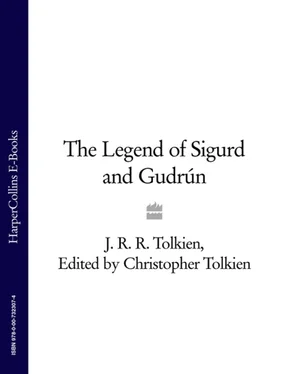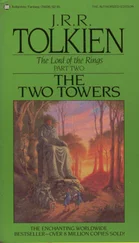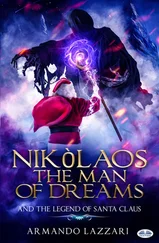J. Tolkien - The Legend of Sigurd and Gudrún
Здесь есть возможность читать онлайн «J. Tolkien - The Legend of Sigurd and Gudrún» — ознакомительный отрывок электронной книги совершенно бесплатно, а после прочтения отрывка купить полную версию. В некоторых случаях можно слушать аудио, скачать через торрент в формате fb2 и присутствует краткое содержание. Жанр: Старинная литература, на английском языке. Описание произведения, (предисловие) а так же отзывы посетителей доступны на портале библиотеки ЛибКат.
- Название:The Legend of Sigurd and Gudrún
- Автор:
- Жанр:
- Год:неизвестен
- ISBN:нет данных
- Рейтинг книги:5 / 5. Голосов: 1
-
Избранное:Добавить в избранное
- Отзывы:
-
Ваша оценка:
- 100
- 1
- 2
- 3
- 4
- 5
The Legend of Sigurd and Gudrún: краткое содержание, описание и аннотация
Предлагаем к чтению аннотацию, описание, краткое содержание или предисловие (зависит от того, что написал сам автор книги «The Legend of Sigurd and Gudrún»). Если вы не нашли необходимую информацию о книге — напишите в комментариях, мы постараемся отыскать её.
The Legend of Sigurd and Gudrún — читать онлайн ознакомительный отрывок
Ниже представлен текст книги, разбитый по страницам. Система сохранения места последней прочитанной страницы, позволяет с удобством читать онлайн бесплатно книгу «The Legend of Sigurd and Gudrún», без необходимости каждый раз заново искать на чём Вы остановились. Поставьте закладку, и сможете в любой момент перейти на страницу, на которой закончили чтение.
Интервал:
Закладка:
The Burgundians are not referred to at all in Beowulf. Neither are many, certainly renowned, figures of Germanic story. The argument from silence is peculiarly perilous in dealing with remnants so haphazard and tattered as those we possess of Old English heroic traditions; and might seem absurd when applied to Beowulf , which is a poem, not a catalogue. Yet it actually has some point in this case. The Burgundian names were known to Old English, and the subjects of verse and tale. We cannot be certain that such a connexion was not present to the mind of the author of Beowulf. But it does not look like it.
The Burgundians are indeed known. But where we meet them in Old English, we find an exact reversal of the case in Beowulf . No reference, at any rate, is made to their connexion with Sigemund Wælsing. The very early poem Widsith reveals a wide-flung interest in a huge nexus of legend: admittedly, specially devoted to the Goths or the northern sea-peoples, but it is not silent on more southern Germanic topics. It refers to Guðhere and to Gifica. It does not refer at all to Sigemund, or Wælsing, or Fitela, or the dragon. ( Widsith has indeed a specially historical tendency.)
Certain reference to the ‘Wælsingas’ is indeed in Old English literature confined to Beowulf . [My father added ‘literature’ on account of the place-name Walsingham in Norfolk.] If we add to this the absence in nomenclature of the special names peculiar to this story in its full-grown form (Guðrún, Grímhild, Brynhild) we shall be forced at the outset to conclude that it is probable:
that Sigemund Wælsing had no pre-eminent place in Old English traditions, in spite of the words wreccena mærost used of him in Beowulf [in the translation given above ‘of adventurers the most renowned’], which may be no more than poetic for ‘a famous adventurer’;
that his tale from the earliest times was of the more mythical-legendary kind – not one of the historical-legendary traditions;
that it was not concerned with Burgundians, who certainly were originally figures of history, but with the dark background of the story that in High German had practically faded out of memory: the part that in Old Norse (though remodelled and drastically altered) concerns the mysterious Odinic Völsungs before the advent of Sigurd. The names are Sigemund, Fitela, Wælsing: these we can find trace of (even outside Beowulf ). The names – women’s names especially – which mark the vital connexion with the Burgundians and their fall cannot be discovered in Old English times in Old English form.
These are only probable considerations. But they are important even so. For the tone, manner, and details of the Old English references are peculiarly important. In general we are likely to get in Old English allusions to an earlier state in legendary development, before the confusion or combinations of later days in other lands. It is therefore vital to note that the most reasonable interpretation of Old English material is that the Sigemund story was originally of an older more mythical type; that it co-existed with the Burgundian legend, but was not yet connected with it.
The major problem raised by the passage in Beowulf in its relation to the Norse story as it appears in the Völsunga Saga is of course the fact that in Beowulf Sigemund is famed for his slaying of a dragon and the gaining of its treasure hoard, whereas in Norse Sigmund has nothing to do with any dragon, and it is Sigmund’s son Sigurd who is the famous dragon-slayer. Some scholars have held that Sigemund’s dragon in Beowulf originally belonged to Sigurd, but was transferred to Sigemund when the two came to be linked as father and son. Others have said that there is no reason to suppose that the author of the Old English poem had ever heard of Sigurd. Some have said that Sigemund and Sigurd were originally wholly independent heroes; others, that one hero became divided into two.
My father accepted that his view was necessarily speculative, but nonetheless favoured it strongly.
‘We cannot tell if Old English knew of a famous son of Sigemund. But in favour of the highly probable answer “it did not” are these considerations.
‘In the first place, great heroes ( wreccena maerost ), especially if untrammelled by history, are apt to generate sons who carry on or duplicate their father’s deeds, to satisfy the desire for more, or to introduce new elements, or to link with other tales.
‘In the second place, no such son is anywhere mentioned in Old English.
‘And in the third place, when such a son appears, his function is solely to connect with and become a chief character in the Burgundian story, to bring the gold into it – and where he exists he has his father’s dragon and gold exploits attached to him. But in Old English these are not yet detached from Sigemund.’
My father did not discuss in his lecture notes other and strongly divergent opinions on this subject, apart from some remarks on the view that Sigemund’s dragon in Beowulf is a dragon of a very different sort from Sigurd’s, and that in fact they were unconnected. ‘But it is a dragon,’ he wrote. ‘And dragons are not common as essential actors in Germanic stories – in spite of the impression given by their being prominent in the Völsung stories and Beowulf. It is highly unlikely – however different in detail – that there should be no connexion between Sigemund’s wyrm and Fáfnir.
‘This of course is immeasurably strengthened if we believe that in order to connect with the Guðhere (Gundahari, Gunnar) stories a son was given to Sigemund (naturally his name begins with Sige- ), but that this stage, presumably reached in Low or High Germany first, was not reached in Old English (which probably drew from archaic sources, and did not reflect the state of the legend contemporarily in Scandinavia and Germany about the year 800 or later).’
He thought also that the origin of the re-forging of the great sword Gram ( Gramr ) – carried by both father and son – is to be found here. The fact that the second element in the son’s name is not constant seemed to be significant. In Old Norse he is Sigurðr, derived from a deduced earlier form Sigiwarð, in Old English Sigeweard, later Siward; whereas the German name is quite distinct: Siegfried ( Sîfrit ) corresponds to an Old English Sigefriþ. That the element mund in the father’s name is constant points, he thought, to its being the older form.
His belief that, as he said, we are in the presence of the duplication of a hero and his marvellous sword of strange origin – as opposed to the view that the father and the son were once entirely distinct and unconnected beings – leads to the conception, in his words, of a legendary hero of supreme valour and beauty, whose name began with the element Sige- ‘victory’. The gleaming eyes of Sigurd (the Lay of the Völsungs VIII.29, IX.26,59) are probably an original trait. In all probability his most renowned exploits concerned a dragon and a hoard, and – possibly – a mysterious, half-supernatural bride.
Questions fundamental to the genesis of the legend are how it came about that the ‘Dragon-hero’ intruded into the story of Attila and the Burgundians, why the treasure-hoard of this hero was called the Hoard of the Nibelungs, and why the Burgundians themselves came to be called the Nibelungs. In the only lecture-notes of my father’s on these matters, or at any rate in the only ones that survive, he indicated his own views very briefly (and not at all points in a way easy to interpret), no doubt because his primary concern was with the Sigemund passage in Beowulf. I shall not therefore enter into any close account of the numerous attempts to solve these baffling and tantalizing questions, but do no more than sketch out some essential aspects. I have also of necessity avoided reference to the German tradition, represented primarily by the Nibelungenlied , except where its evidence is essential even within these limits.
Читать дальшеИнтервал:
Закладка:
Похожие книги на «The Legend of Sigurd and Gudrún»
Представляем Вашему вниманию похожие книги на «The Legend of Sigurd and Gudrún» списком для выбора. Мы отобрали схожую по названию и смыслу литературу в надежде предоставить читателям больше вариантов отыскать новые, интересные, ещё непрочитанные произведения.
Обсуждение, отзывы о книге «The Legend of Sigurd and Gudrún» и просто собственные мнения читателей. Оставьте ваши комментарии, напишите, что Вы думаете о произведении, его смысле или главных героях. Укажите что конкретно понравилось, а что нет, и почему Вы так считаете.












